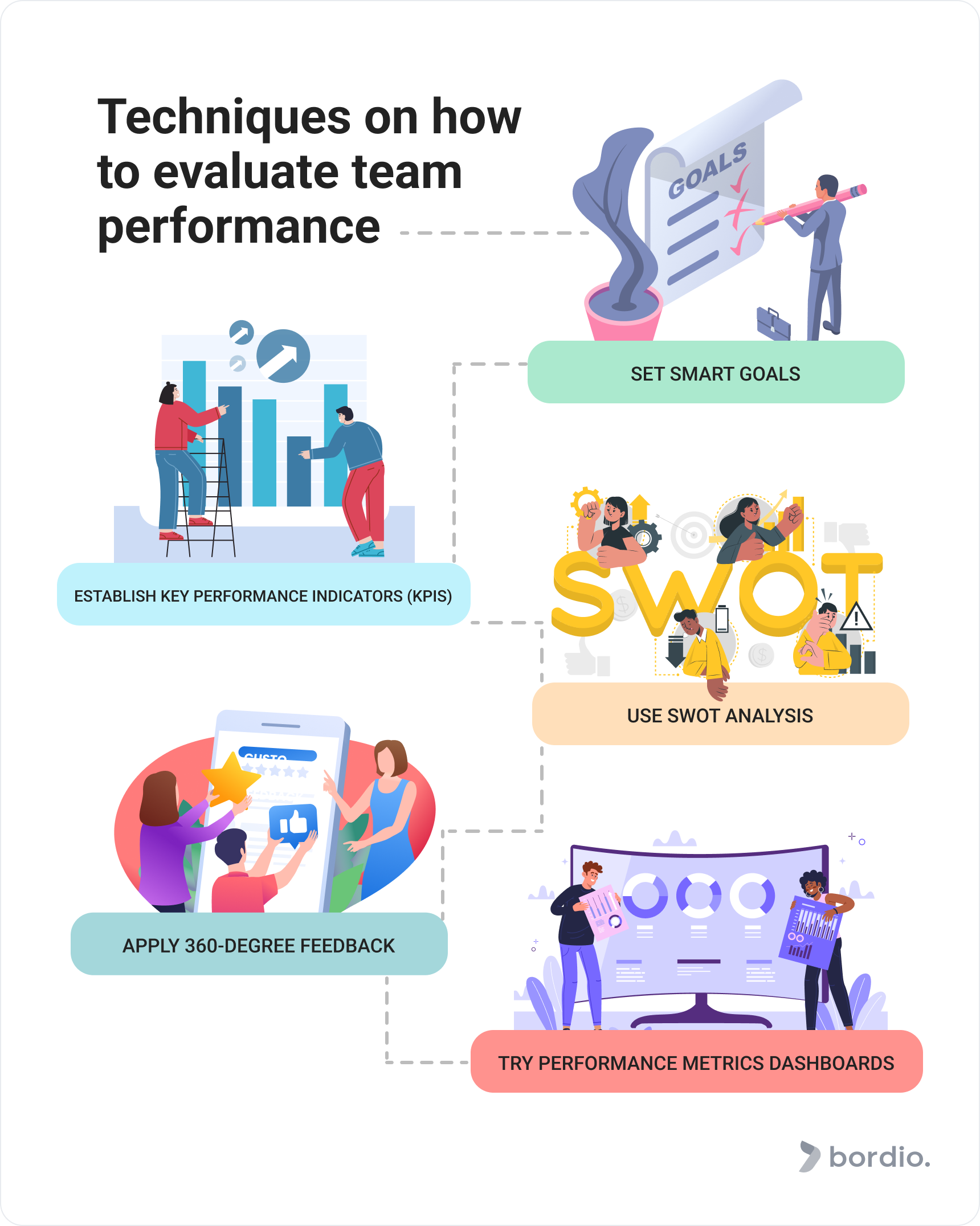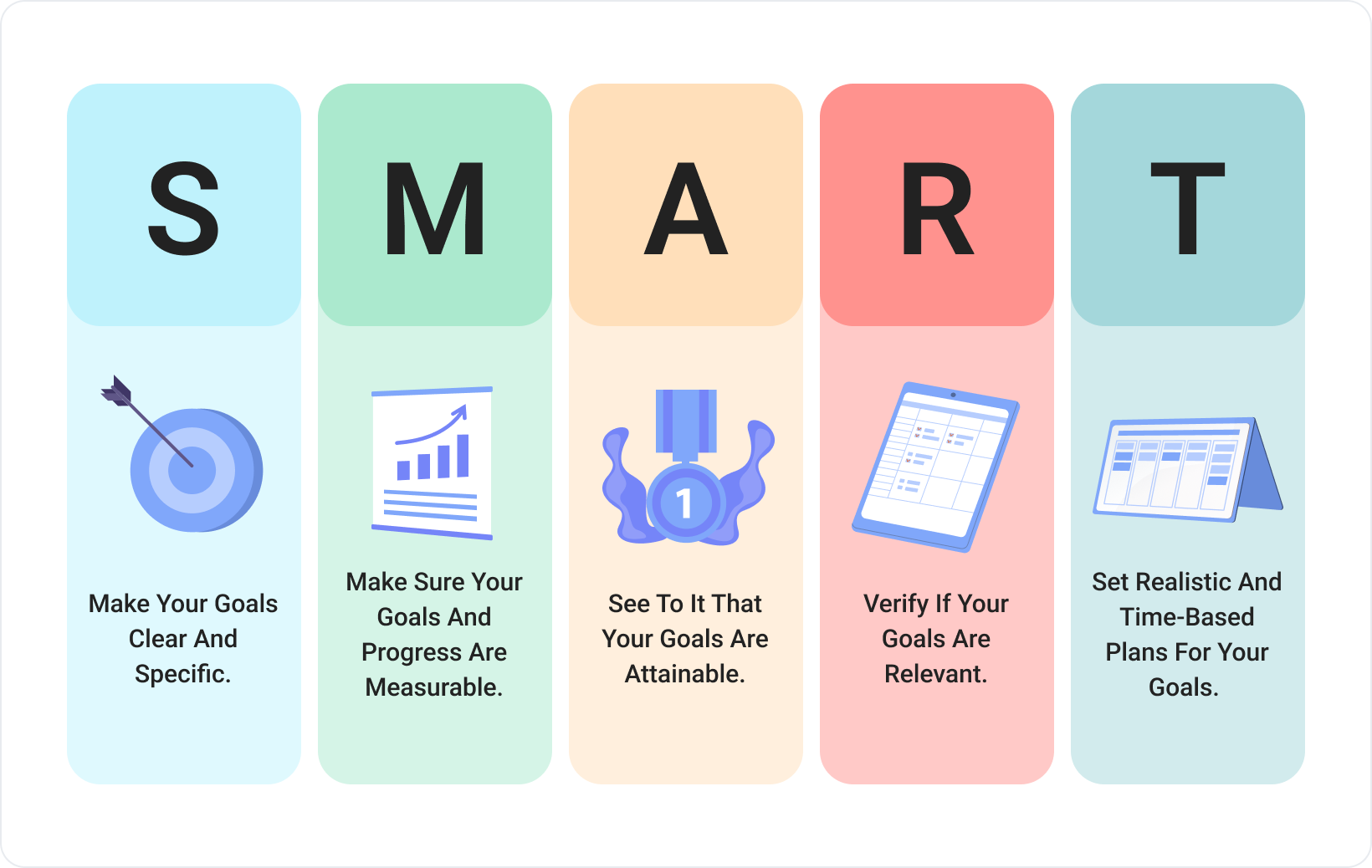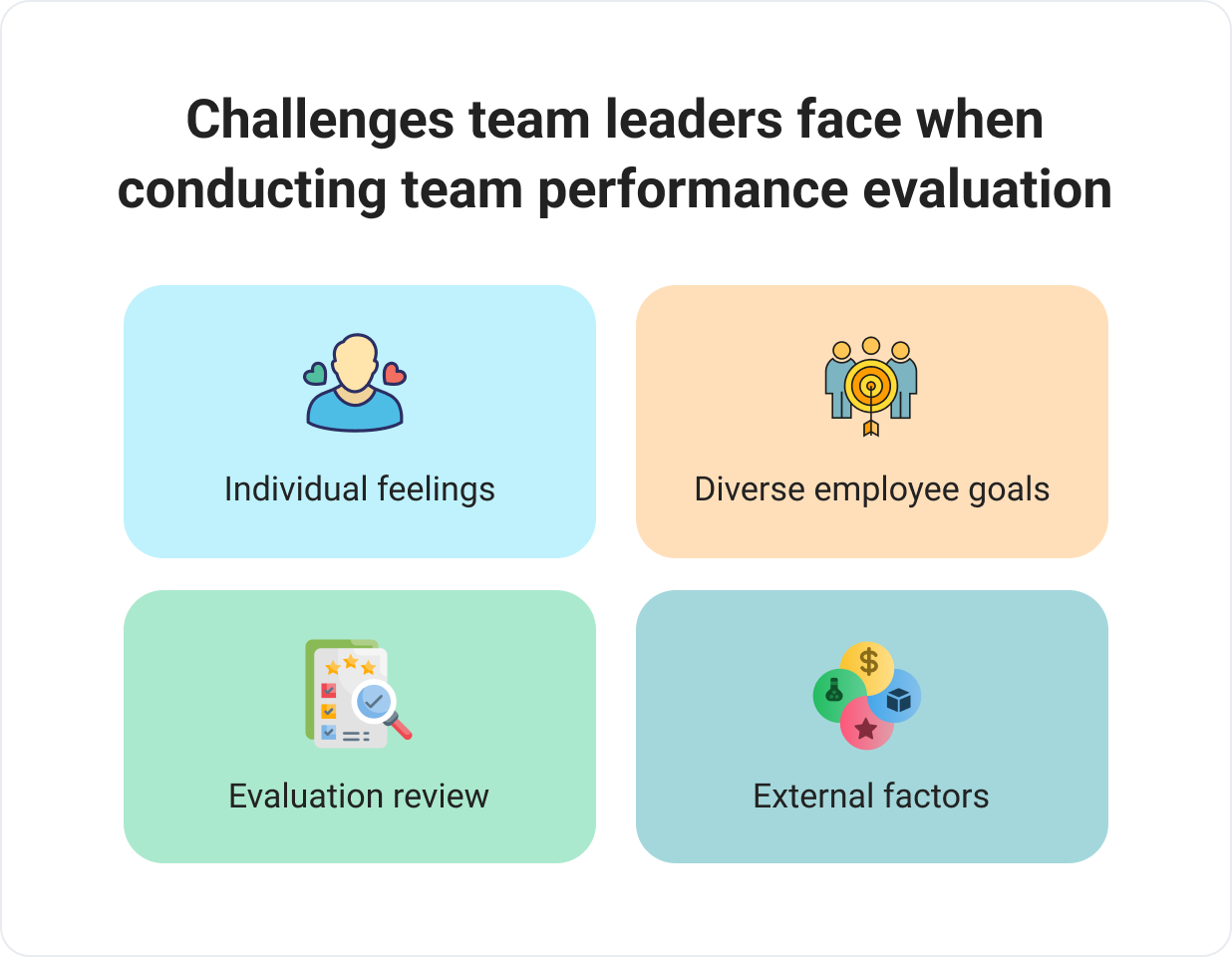We often neglect evaluating team performance after finishing a project, especially if the project is successful. The last thing you want to do as a team and as leaders is to go back and nitpick through each detail of your task because you just want to rest and enjoy your success or just move forward with your next projects. However, evaluating team performance is essential to finding room for improvement.
Let this article guide you by answering the questions “What, why, when, and how?” of the techniques for evaluating team performance to help you implement performance management for your team’s future projects.
Team performance assessments: What are they?
Team performance evaluations examine your employees’ productivity levels, including how successfully your group members collaborate, generate outcomes, and drive change to guarantee the company’s overall success.
Team effort is not the only ingredient in successful teams. It is also your ability as a leader to evaluate the team’s effectiveness and progress through performance metrics and identify challenges for continuous learning.
You should always remember that there are a lot of opportunities for improvement; you just have to identify areas that need development to boost team performance and team dynamics.
Why do you need to evaluate your team’s performance?
As we have mentioned earlier, after finishing a project, successful or not, we just want to move forward and accomplish the next task. What many don’t realize is that team evaluation can actually help you get things done more efficiently.
Here are some points why it is essential to assess your team’s progress:
- It helps you analyze the capabilities and weaknesses of the group that can either increase or impede the quality of their work
- You can pinpoint issues within the team that may have surfaced and may be hindering the goal-setting of the organization
- Devising the right metrics in evaluating your team’s performance also helps you in exploring ways to restructure for better team competency, efficiency, productivity, and quality
- Helps in establishing ways to improve employee engagement, job satisfaction, and customer satisfaction
When do you need to evaluate your team’s performance?
Regular check-ins with your employees can help you in collecting feedback through team member evaluation interviews. Doing frequent assessments can also give you a comprehensive overview of the organization.
Project management tools can facilitate your evaluation. We recommend utilizing them because they help you and your employees identify key challenges to your project goals.
Evaluations are usually conducted quarterly or annually, which helps provide a thorough summary of accurate information on an employee’s effectiveness over a given period.
Although evaluations are commonly administered quarterly or annually, in general, there are four ideal times to conduct an evaluation of the team productivity:
- When the group attempts to accomplish objectives, goals, or plans but encounters obstacles and problems, this could apply to circumstances including shifting client demands, problems with suppliers, modifications to regulations, actions by competitors, and challenging economic conditions.
- When the team’s internal dynamics shift due to new or departing members, changes in the project’s scope, demands from internal stakeholders, resource contributions, pressing requests, rearranging tactics, or the search for fresh ideas and inventiveness.
- When a team is working well and comparatively stable, you want to keep an eye on things and ensure nothing is going wrong so that the team doesn’t perform poorly in the future.
- In order to assess a team’s overall strength and well-being and their proactivity in comprehending and handling upcoming tasks, it’s one of those times when you should measure their capabilities and performance.
Techniques on how to evaluate your team’s performance
We think it’s quite common for managers to ask, “How do you evaluate team performance?” Performance evaluations don’t only involve checking to-do lists. We have many things to consider when evaluating team performance, so let our tips guide you in this journey.
Set SMART goals to evaluate team performance easily
Defining SMART goals is your trusty and go-to tip for most successful teams. It is widely used because it is proven to help the team improve. If you are not yet familiar with what SMART goals mean, let us help you. It stands for Specific, Measurable, Achievable, Relevant, and Time-bound.
This process helps you have a well-rounded view of setting realistic expectations for the team and provides important metrics for self-assessments. SMART goals also help your members set their own goals and share them with other team members to achieve overall success.
Establishing Key Performance Indicators (KPIs)
Setting up KPIs is essential in coordinating defined goals. Quantitative metrics help your team identify preplanned benchmarks. The use of quantitative measures in KPIs provides a clear, quantifiable assessment, which helps collect data in various aspects of the group environment.
Customizing KPIs to each team member’s individual goals helps ensure that their performances align with their objectives.
What are the five commonly used KPIs?
- Revenue growth
- Revenue per client
- Profit margin
- Client retention rate
- Customer satisfaction
Through these key performance indicators, you can get a clear picture of how the company is doing, enabling you to determine whether to keep things as they are or whether to shift course.
SWOT Analysis
Another tip we can share on evaluating team performance is using SWOT Analysis. This evaluation process is a strategic planning tool that supports team building by reviewing your team’s performance data and assessing their Strengths, Weaknesses, Opportunities, and Threats.
SWOT Analysis helps your team address and overcome key challenges affecting their performance metrics. This will help in backtracking one project, then revisit project goals – considered successful or not, so employees can check their own completion rates, turnover rate, and quality of work. We assure you that heeding this tip will be advantageous to each team member in their own progress, which will eventually trickle down to the whole group’s success.
360-degree feedback
360-degree feedback is another useful technique that we recommend for assessing the performance of your team members.
Definition: It is a strategy of employee review that gives each worker a chance to hear real-time feedback about their performance from four to eight peers, managers, reporting staff, and, occasionally, customers in addition to their supervisor or manager.
With this method, you can thoroughly and unbiasedly assess your teams’ possibilities, problems, strengths, and shortcomings to prepare them for future projects. It also helps you find and close any gaps or discrepancies in your assessment of your team’s performance and that of others. Because 360-degree feedback encourages your team members to seek out and give honest, constructive feedback to one another, it also promotes continual learning and progress as a group.
If you want to apply this technique, 360-degree feedback, to your own company, you must create and distribute an offline survey that addresses a range of topics related to performance for your teams. It must include abilities, actions, attitudes, values, and results. You can introduce it during team meetings to give your members a heads-up about your plan.
Performance Metrics Dashboards
Performance dashboards play a crucial role in facilitating proactive decision-making by offering real-time visibility into individual and group performance. These dashboards promote teamwork by allowing your members to monitor progress together and contribute to common goals.
Digital tools, such as project management platforms, may allow for more accurate and easy access to performance data. In addition to streamlining the tracking procedure, these solutions offer a central location for cooperative efforts, guaranteeing that all group members agree on project milestones and overall performance.
Tip: Try Bordio as your team management software. This digital tool allows for efficient teamwork with its user-friendly interface that makes working easier and more enjoyable.
Bonus tips on how to evaluate your team
While we think we have provided you with excellent techniques that can help you evaluate the general performance of your workforce, we’d like to share bonus tips that can boost your team’s efficiency in the same way as the strategies we have discussed above.
Interview your team members
When you manage your team’s performance, you must remember to conduct evaluation interviews in both group and individual settings. Find out how each person feels, what their different perceptions are, any worries they may have, and what they believe functions effectively. This presents a chance for you leaders and the specific employee to exchange constructive criticism without any fears of not being heard.
Listen to your people
As team leaders, you should listen to your people, and we mean really hear them. Pay attention to their actions, as they might be intimidated to share their thoughts, which might hinder you from evaluating them properly and giving them the right advice to help them improve.
Make sure every worker feels at ease in your presence. If you sense that they are withholding something, try posing the topic differently. Just make sure they are comfortable so they can freely share what’s on their minds.
Revisit and review your project goals
It is crucial to revisit and review your project’s initial objectives before diving into the evaluation procedures. You can become more knowledgeable and in the correct state of mind to make reasonable conclusions by taking a step back. Your assessment might be biased if you’re always thinking about the results.
Tools to help you monitor team performance
We are already in the modern age, so everything is just a click away. We have to use the gift of the internet because, let’s be real, it is effective and helps us attain the most coveted workload and work-life balance.
- Online task planner – We suggest you try Bordio’s online task planner for teams. It’s an all-in-one app that help you meet all the demands of modern work life. We promise, you won’t regret it!
- Time management tools – These tools are must-haves as they are excellent for project management and supervising deadlines. They give you a general overview and estimates of your commitments and help you sort things out.
- Collaboration tools—A number of collaboration tools have emerged in the last decade, especially with the rise of remote work. Some of the more commonly used ones are Bordio, Zoom, Slack, and Microsoft Teams. You just have to choose which tool will cater to your needs.
Challenges team leaders face when conducting team performance evaluation
When you think of starting and conducting an evaluation process in your company, you have to be ready for some challenges coming your way, which is normal. No matter how big or small projects are, you will always encounter bumps along the way.
We have listed some of the usual challenges that companies experience when evaluating team performance so you can be ready when you decide to “manage people performance” in your own team.
Considering individual feelings when you evaluate team performance
You don’t want to hurt your employees’ feelings as a team leader. Team leaders struggle to give feedback while avoiding frustrating or alienating a team member or even the entire team.
The possibility that evaluations will irritate or dishearten employees is a major problem. Employees who are driven by achievement could find it difficult to accept that their group’s work is assessed in addition to or instead of their individual performance. Group members’ tendency to hold one another accountable for their respective output and performance can also lead to conflict. Although one of the purposes of this rating method is to encourage employees to prioritize the team’s goals over their own, you still need to keep an eye on and manage these disputes.
Diverse employee goals
Whatever setting it is, at work, in school, or even at home, we all have distinct, individual goals and driving forces. Within your company’s teams, some people may be driven primarily by financial gain or competitiveness, while others may just want to fit in and play their role.
Team members who are role players and high performers sometimes argue. While role players could feel under constant pressure to perform things they’re uncomfortable with, high achievers might feel like they carry greater weight. This difficulty is minimized by well-built teams, a culture of open communication, and close alignment of team objectives with corporate goals.
Evaluation review
We all know that change is constant, which is also 100% true when it comes to changes in team responsibilities, tasks, and even work method standards. Due to constant changes, it’s best to regularly review team evaluations to ensure that the criteria to measure and evaluate team performance are still appropriate in quantifying group accomplishments.
External factors
There will always be things beyond our control. So, we want to warn you that your teams may also experience frustration if external factors or influences negatively impact their performance. Your sales teams may be given varying quotas depending on your company’s products, market, and experience.
If team evaluation is one-dimensional or not flexible, it can be a matter of concern for your employees, and they might feel demoralized during team evaluation processes.
Final thoughts evaluating team performance
We hope that we have shared with you comprehensive answers on the what, why, when, and how of the techniques of measuring team performance. They may be difficult to digest initially, but trust us, they all work!
These methods are just the tip of the iceberg because there are still many strategies out there that need to be explored. Don’t worry; in our next articles, we will compile and discuss more of these to help out in any way we can.
We also encourage you to check out other similar posts on our page if you want to learn more about team performance as well as productivity hacks.











